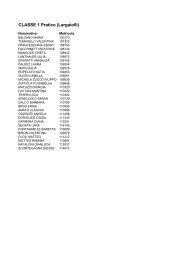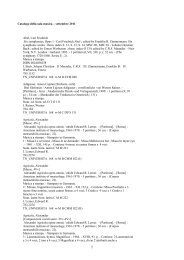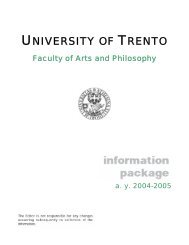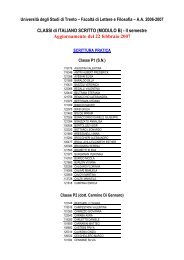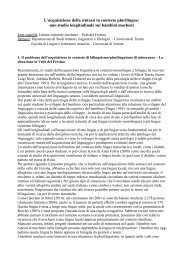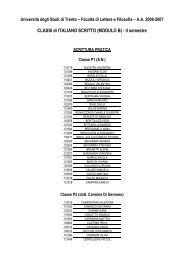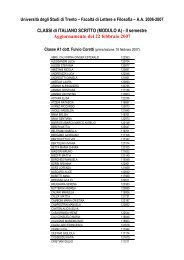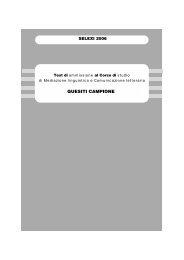PISA Under Examination - Comparative Education Society in ...
PISA Under Examination - Comparative Education Society in ...
PISA Under Examination - Comparative Education Society in ...
You also want an ePaper? Increase the reach of your titles
YUMPU automatically turns print PDFs into web optimized ePapers that Google loves.
M.A. PEREYRA, H. KOTTHOFF AND R. COWEN<br />
Javier Sal<strong>in</strong>as and Daniel Santín analyse the <strong>PISA</strong> reports and results from the<br />
economics of education perspective. In their paper the authors present an overview of<br />
the problems related to the assessment of efficiency <strong>in</strong> education and describe how<br />
the <strong>PISA</strong> data have been used for carry<strong>in</strong>g out these studies. The possibility of<br />
obta<strong>in</strong><strong>in</strong>g educational data every three years for many countries allows economists of<br />
education to keep study<strong>in</strong>g the technological relationship between educational <strong>in</strong>puts<br />
and outputs. The aim of a major part of the research done with <strong>PISA</strong> is to measure<br />
the productivity of educational resources and to establish the efficiency level of the<br />
schools responsible for produc<strong>in</strong>g education. The paper discusses the ma<strong>in</strong><br />
educational concepts that have been used <strong>in</strong> empirical studies to measure productivity<br />
us<strong>in</strong>g the data com<strong>in</strong>g from <strong>PISA</strong> and summarizes the ma<strong>in</strong> results obta<strong>in</strong>ed thus far:<br />
e.g. that a greater decision-mak<strong>in</strong>g autonomy at the school-level tends to be<br />
associated with higher levels of efficiency or that, hold<strong>in</strong>g resources constant, <strong>PISA</strong><br />
scores could be boosted by an average of 5% for OECD countries etc. In their<br />
conclusion, the authors stress that the <strong>PISA</strong> reports constitute a very valuable source<br />
of <strong>in</strong>formation for the analyses of educational efficiency and that they provide very<br />
useful <strong>in</strong>formation for evaluat<strong>in</strong>g educational policy. F<strong>in</strong>ally, the authors provide<br />
some concrete advice on what additional <strong>in</strong>formation should be <strong>in</strong>cluded <strong>in</strong> future<br />
<strong>PISA</strong> reports <strong>in</strong> order to improve the quality of the empirical analyses that could be<br />
conducted us<strong>in</strong>g <strong>PISA</strong> data (establish<strong>in</strong>g a longitud<strong>in</strong>al database etc.).<br />
The fourth part of this volume entitled “<strong>PISA</strong> and the Immigrant Student<br />
Question” focuses on the potential of <strong>PISA</strong> for the analysis and understand<strong>in</strong>g of one<br />
specific aspect, which is of major importance for most education systems: <strong>in</strong> many<br />
countries immigrant students lag beh<strong>in</strong>d their peers from native families <strong>in</strong> terms of<br />
achievement and school success. The relatively poor performance of immigrant<br />
students <strong>in</strong> <strong>PISA</strong> tests has been one of the most controversial issues <strong>in</strong> the <strong>in</strong>tense<br />
debate about the <strong>PISA</strong> results. In this part of the volume two papers are presented<br />
which both draw on <strong>PISA</strong> data, but arrive at very different explanations with regard<br />
to the reasons for this performance gap between native and immigrant students.<br />
Aileen Edele and Petra Stanat assess <strong>PISA</strong>’s potential for analyses of<br />
immigrant students’ educational success by referr<strong>in</strong>g to the German case. The<br />
authors start by claim<strong>in</strong>g that large-scale assessment studies, such as <strong>PISA</strong>, “have<br />
advanced our understand<strong>in</strong>g of immigrant students’ educational disadvantage<br />
considerably” (p. 175) and they prove their po<strong>in</strong>t by contrast<strong>in</strong>g what was known<br />
about the immigrants students’ educational disadvantage <strong>in</strong> the German school<br />
system before and after <strong>PISA</strong>. Accord<strong>in</strong>g to the authors, the <strong>PISA</strong> study established<br />
a more comprehensive <strong>in</strong>dicator of immigration background by record<strong>in</strong>g students’<br />
and parents’ countries of birth, which proved that immigration <strong>in</strong>to Germany was<br />
much higher than earlier German studies (e.g. Microcensus), which had def<strong>in</strong>ed<br />
immigrants strictly on grounds of their citizenship rather than their migration<br />
history, had shown. On the basis of the <strong>PISA</strong> data, Edele and Stanat are able to<br />
identify determ<strong>in</strong>ants of immigrant students’ disadvantages <strong>in</strong> German schools on<br />
different levels. On the national/societal level immigration and <strong>in</strong>tegration policies<br />
as well as differences <strong>in</strong> the approaches to support second language acquisition<br />
seem to play a crucial role. On the school level and with regard to the composition<br />
10




